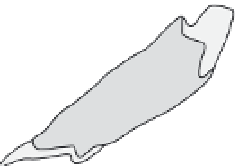Geology Reference
In-Depth Information
tend to cluster in time or space (Fig. 6.1)? How
variable are fault slip rates and how do they
compare with geodetic rates or million-year
geological rates (Fig. 5.1)? Some of the most
potent insights on the seismological behavior of
the shallow crust seem to derive from two
regions: the region lying above the extensive
Sumatran subduction zone, and the region
encompassing the North America-Pacific
transform plate boundary in southern California.
The former region is remarkable for the
widespread, detailed chronologies of seismically
driven emergence and submergence as shown in
the coral records, whereas the latter region has
benefited from more than 30 years of extensive
study, much of it under the aegis of the Southern
California Earthquake Center. In this latter
region, not only has the longest age-constrained,
earthquake-by-earthquake record of slip been
developed (Box 6.3), but many dozens of
paleoseismological studies on the active faults
of southern California have rendered this the
most broadly studied and best-dated region in
the world.
Rockfall-Based
Seismic Shaking
168°E
172°E
0
100
200
Ms 7.8
km
no
data
42°E
seismic-
shaking
index
Ms 7.1
>80
60-80
40-60
<40
South Island
Fig. 6.27
Seismic shaking index map for the effects
of two earthquakes.
Two large earthquakes occurred in 1929 in the northern
South Island, New Zealand. Contoured map shows shaking
indices for the 16 mm (1929) diameter lichen peak for 53
sites. The epicenter and magnitude of the earthquakes are
shown. The
M
s
= 7.1 earthquake (depth
∼
15 km) caused
strong shaking in an area concentric to the epicenter,
whereas the larger
M
s
= 7.8 earthquake affected a broader
region. Note that no data are available to the northwest of
the shaded areas. Modified after Bull
et al.
(1994).
This remarkable result has significant social
applications. When environmental assessments
are made for construction of buildings intended
for “high-risk” usage (nuclear power plants or
chemical manufacturers), the question is often
posed: “Are there any faults within a certain
distance that have been active during Holocene
times?” When faults do not break the surface,
this question can be particularly difficult to
answer. If lichenometric dating of rockfalls
resulting from seismic shaking can quantify
prehistoric events, and even specify previous
epicentral areas, this analysis could provide
valuable insights for paleoseismic studies.
Time-predictable or slip-predictable
earthquakes
Very few records have sufficient length, reliable
limits on coseismic slip, and precise enough
dating to provide robust tests of time or slip
predictability. The two best data sets seem to
provide different answers. The best-dated
earthquake sequence of the long Wrightwood
time series suggests that faulting on the
southern San Andreas Fault is neither slip- nor
time-predictable (Box 6.3). On the other hand,
the coral-based data from Sumatra (Sieh
et al.
,
2008) for the past seven centuries suggest an
overall time-predictable behavior (Fig. 6.28).
Gathered from sites spanning more than 100 km
along strike above the subduction zone, the
Sumatran data argue for megasequences of
great earthquakes spaced about every 200
years. Sometimes the largest earthquake has
been preceded over several decades by one or
several smaller ones. The overview of the entire
sequence from all three sites, however, indicates
Paleoseismic insights on fault behavior
Given the wealth of new paleoseismological
data accruing from studies around the world,
one would hope that clear answers would
emerge to some of the overarching questions
about fault behavior: Are faults slip-predictable
or time-predictable (Fig. 4.4)? Do seismic events































































